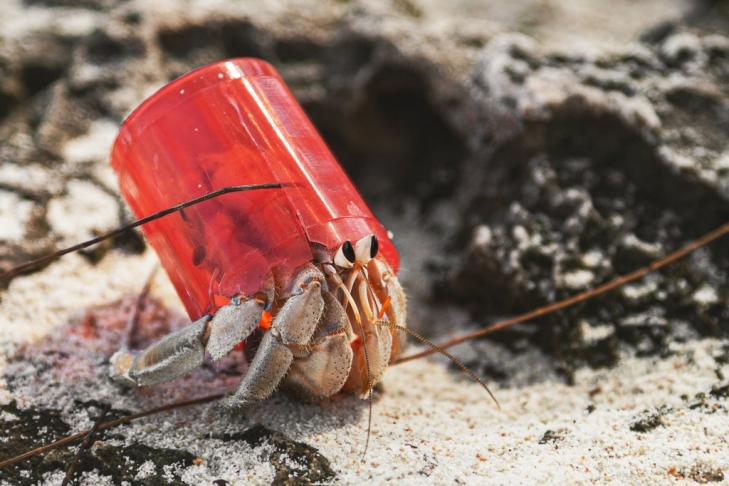
According to a study published in February in the journal Science of the Total Environment, hermit crabs (寄居蟹) are using plastic litter as shells.
Zuzanna Jagiello is the study’s lead author. “A hermit crab in a plastic shell could be an icon of our times,” Jagiello told TIME for Kids. “They don’t have homes, so they use rubbish.” Jagiello studies the Anthropocene age. That’s the geologic (地质的) age we’re in now. Scientists define it as the period in which human activity has had a major impact on the environment. Hermit crabs using plastic waste as shells is one example of that impact.
Hermit crabs are small, soft-bodied crabs that live near oceans. To protect themselves from predators, the crabs typically wear seashells that have been left behind by dead sea snails. But according to February’s study, at least 386 hermit crabs have been documented wearing garbage. Of the world’s 16 species of hermit crabs that live on land, 10 have been seen wearing trash. Nearly nine out of every 10 of those crabs were wearing plastic waste, such as bottle caps. The others wore glass or metal, such as broken lightbulbs or soda cans.
Jagiello says that she and her team first learned about hermit crabs wearing garbage when they noticed photos of them posted online. They decided to learn more by conducting research (see “Internet Ecology”). For their study, the researchers scanned the Internet for photos of hermit crabs wearing trash. They found photos from all over the world. Some had been taken by scientists. Some had been taken by nature photographers. Many had been taken by people who were just curious.
Scientists agree that plastic pollution harms wildlife and habitats in many ways. But they aren’t sure why hermit crabs are choosing litter instead of sea snail shells, nor are they sure if the crabs are in any danger. “It’s really an amazing example of how some animals are coping with the Anthropocene age,” Jagiello says. “What are the long-term consequences of these adaptations? We don’t know.”
1.What does Jagiello mean by saying the underlined sentence in Paragraph 2?
A It is important to protect the endangered species.
B It’s no longer fit for hermit crabs to live near oceans.
C Humans have seriously affected the environment.
D People should greatly reduce their use of plastic.
解析:选C。C 句意理解题。根据第二段最后三句“That’s the geologic (地质的) age we’re in now. Scientists define it as the period in which human activity has had a major impact on the environment. Hermit crabs using plastic waste as shells is one example of that impact.”这就是我们现在所处的地质时代。科学家将其定义为人类活动对环境产生重大影响的时期。寄居蟹用塑料垃圾做壳就是这种影响的一个例子。可知,Jagiello说这句话意在强调人类已经严重影响了自然环境。故选C。
2.Which is the percentage of hermit crabs using plastic litter as shells?
A Nearly 39%.
B Nearly 60%.
C Nearly 75%.
D Nearly 90%.
解析:选D。D 细节理解题。根据第三段倒数第二句“Nearly nine out of every 10 of those crabs were wearing plastic waste”每10只寄居蟹中就有接近9只穿着塑料垃圾,即接近90%的寄居蟹用塑料垃圾做壳。故选D。
3.How did Jagiello and her team conduct their study?
A By taking pictures of hermit crabs.
B By viewing online photos worldwide.
C By contacting scientists studying crabs.
D By collecting information from curious people.
解析:选B。B 细节理解题。根据第四段中的“For their study, the researchers scanned the Internet for photos of hermit crabs wearing trash. They found photos from all over the world.”在他们的研究中,研究人员仔细查看了互联网上用塑料垃圾做壳的寄居蟹的照片。他们找到了来自世界各地的照片。由此可知,他们通过查看网络上的照片来展开他们的研究。故选B。
4.What’s scientists’ attitude towards the future of hermit crabs?
A Unconcerned.
B Hopeless.
C Optimistic.
D Unsure.
解析:选D。D 推理判断题。根据最后一段中的“nor are they sure if the crabs are in any danger”以及“What are the long-term consequences of these adaptations? We don’t know.”可知,科学家们对这些寄居蟹的未来会怎么样并不确定。故选D。